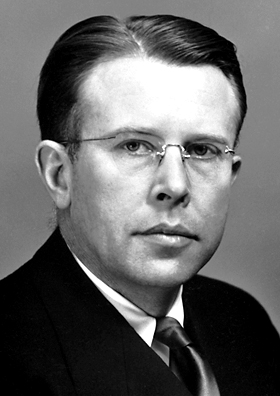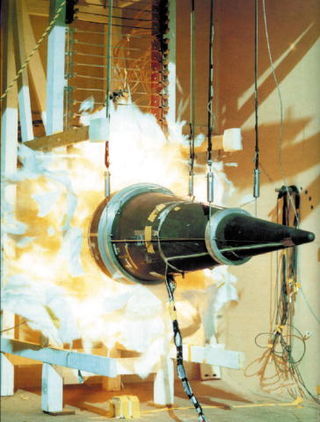Related Research Articles

Glenn Theodore Seaborg was an American chemist whose involvement in the synthesis, discovery and investigation of ten transuranium elements earned him a share of the 1951 Nobel Prize in Chemistry. His work in this area also led to his development of the actinide concept and the arrangement of the actinide series in the periodic table of the elements.

Ultrasound is sound with frequencies greater than 20 kilohertz. This frequency is the approximate upper audible limit of human hearing in healthy young adults. The physical principles of acoustic waves apply to any frequency range, including ultrasound. Ultrasonic devices operate with frequencies from 20 kHz up to several gigahertz.
Lawrence Livermore National Laboratory (LLNL) is a federally funded research and development center in Livermore, California, United States. Originally established in 1952, the laboratory now is sponsored by the United States Department of Energy and administered privately by Lawrence Livermore National Security, LLC.

Ernest Orlando Lawrence was an American nuclear physicist and winner of the Nobel Prize in Physics in 1939 for his invention of the cyclotron. He is known for his work on uranium-isotope separation for the Manhattan Project, as well as for founding the Lawrence Berkeley National Laboratory and the Lawrence Livermore National Laboratory.

Project Pluto was a United States government program to develop nuclear-powered ramjet engines for use in cruise missiles. Two experimental engines were tested at the Nevada Test Site (NTS) in 1961 and 1964 respectively.

Aragonite is a carbonate mineral and one of the three most common naturally occurring crystal forms of calcium carbonate, the others being calcite and vaterite. It is formed by biological and physical processes, including precipitation from marine and freshwater environments.

Project Plowshare was the overall United States program for the development of techniques to use nuclear explosives for peaceful construction purposes. The program was organized in June 1957 as part of the worldwide Atoms for Peace efforts. As part of the program, 35 nuclear warheads were detonated in 27 separate tests. A similar program was carried out in the Soviet Union under the name Nuclear Explosions for the National Economy.

The National Ignition Facility (NIF) is a laser-based inertial confinement fusion (ICF) research device, located at Lawrence Livermore National Laboratory in Livermore, California, United States. NIF's mission is to achieve fusion ignition with high energy gain. It achieved the first instance of scientific breakeven controlled fusion in an experiment on December 5, 2022, with an energy gain factor of 1.5. It supports nuclear weapon maintenance and design by studying the behavior of matter under the conditions found within nuclear explosions.

Battelle Memorial Institute is a private nonprofit applied science and technology development company headquartered in Columbus, Ohio. The institute opened in 1929 but traces its origins to the 1923 will of Ohio industrialist Gordon Battelle which provided for its creation and his mother Annie Maude Norton Battelle who left the bulk of the family fortune to the institute after her death in 1925. Originally focusing on contract research and development work in the areas of metals and material science, Battelle is now an international science and technology enterprise that explores emerging areas of science, develops and commercializes technology, and manages laboratories for customers.

Stockpile stewardship refers to the United States program of reliability testing and maintenance of its nuclear weapons without the use of nuclear testing.

Water softening is the removal of calcium, magnesium, and certain other metal cations in hard water. The resulting soft water requires less soap for the same cleaning effort, as soap is not wasted bonding with calcium ions. Soft water also extends the lifetime of plumbing by reducing or eliminating scale build-up in pipes and fittings. Water softening is usually achieved using lime softening or ion-exchange resins, but is increasingly being accomplished using nanofiltration or reverse osmosis membranes.
Transformer oil or insulating oil is an oil that is stable at high temperatures and has excellent electrical insulating properties. It is used in oil-filled wet transformers, some types of high-voltage capacitors, fluorescent lamp ballasts, and some types of high-voltage switches and circuit breakers. Its functions are to insulate, suppress corona discharge and arcing, and to serve as a coolant.
Peaceful nuclear explosions (PNEs) are nuclear explosions conducted for non-military purposes. Proposed uses include excavation for the building of canals and harbours, electrical generation, the use of nuclear explosions to drive spacecraft, and as a form of wide-area fracking. PNEs were an area of some research from the late 1950s into the 1980s, primarily in the United States and Soviet Union.
Underground coal gasification (UCG) is an industrial process which converts coal into product gas. UCG is an in-situ gasification process, carried out in non-mined coal seams using injection of oxidants and steam. The product gas is brought to the surface through production wells drilled from the surface.

The Lady Godiva device was an unshielded, pulsed nuclear reactor originally situated at the Los Alamos National Laboratory (LANL), near Santa Fe, New Mexico. It was one of a number of criticality devices within Technical Area 18 (TA-18). Specifically, it was used to produce bursts of neutrons and gamma rays for irradiating test samples, and inspired development of Godiva-like reactors.

Boiler feedwater is an essential part of boiler operations. The feed water is put into the steam drum from a feed pump. In the steam drum the feed water is then turned into steam from the heat. After the steam is used, it is then dumped to the main condenser. From the condenser, it is then pumped to the deaerated feed tank. From this tank it then goes back to the steam drum to complete its cycle. The feedwater is never open to the atmosphere. This cycle is known as a closed system or Rankine cycle.

The United States's Flintlock nuclear test series was a group of 47 nuclear tests conducted in 1965–1966. These tests followed the Operation Whetstone series and preceded the Operation Latchkey series.
Richard Freeman Post was an American physicist notable for his work in nuclear fusion, plasma physics, magnetic mirrors, magnetic levitation, magnetic bearing design and direct energy conversion.
A plasma railgun is a linear accelerator which, like a projectile railgun, uses two long parallel electrodes to accelerate a "sliding short" armature. However, in a plasma railgun, the armature and ejected projectile consists of plasma, or hot, ionized, gas-like particles, instead of a solid slug of material. Scientific plasma railguns are typically operated in vacuum and not at air pressure. They are of value because they produce muzzle velocities of up to several hundreds of kilometers per second. Because of this, these devices have applications in magnetic confinement fusion (MCF), magneto-inertial fusion (MIF), high energy density physics research (HEDP), laboratory astrophysics, and as a plasma propulsion engine for spacecraft.
Pulsed-power water treatment is the process of using pulsed, electro-magnetic fields into cooling water to control scaling, biological growth, and corrosion. The process does not require the use of chemicals and helps eliminate environmental and health issues associated with the use and life-cycle management of chemicals used to treat water. Pulsed-power systems have the ability to maintain low levels of microbiological activity without using corrosive chemicals. Several reports have shown that pulse-powered systems yield significantly lower counts of bacteria colony forming units compared to chemically controlled systems.
References
- ↑ Krauter, PW; Harrar, JE; Orloff, SP; Bahowick, SM (1996). "Test of a Magnetic Device for Amelioration of Scale Formation at Treatment Facility D" (PDF). Internal Report. Lawrence Livermore National Laboratory. doi:10.2172/567404. OSTI 567404 . Retrieved 11 December 2009.
- 1 2 Keister, T (2008). "Non Chemical Devices: Thirty Years of Myth Busting" (PDF). Water Conditioning & Purification. Archived from the original (PDF) on 17 April 2012. Retrieved 11 December 2009.
- ↑ Powell, MR (1998). "Magnetic Water and Fuel Treatment: Myth, Magic, or Mainstream Science?". Skeptical Inquirer . 22 (1). Archived from the original on 27 July 2009. Retrieved 26 October 2007.
- ↑ Lower, S. "Magnetic water treatment and pseudoscience". Chem1Ware Systems Limited. Archived from the original on 1 May 2008. Retrieved 25 October 2009.
- ↑ Limpert, GJC; Raber, JL (1985). "Tests of nonchemical scale control devices in a once-through system". Materials Performance. 24 (10): 40–45. OSTI 6089699.
- ↑ Smothers, KW; Curtiss, CD; Gard, BT; Strauss, RH; Hock, VF (15 June 2001). "Magnetic Water Treatment" (PDF). Public Works Technical Bulletin 420-49-34. U.S. Army Corps of Engineers. Archived from the original (PDF) on 15 December 2011.
- ↑ Coey, J.M.D; Cass, Stephen (2000). "Magnetic Water Treatment". Journal of Magnetism and Magnetic Materials. 209 (1–3): 71–74. Bibcode:2000JMMM..209...71C. doi:10.1016/S0304-8853(99)00648-4 . Retrieved 23 August 2023.